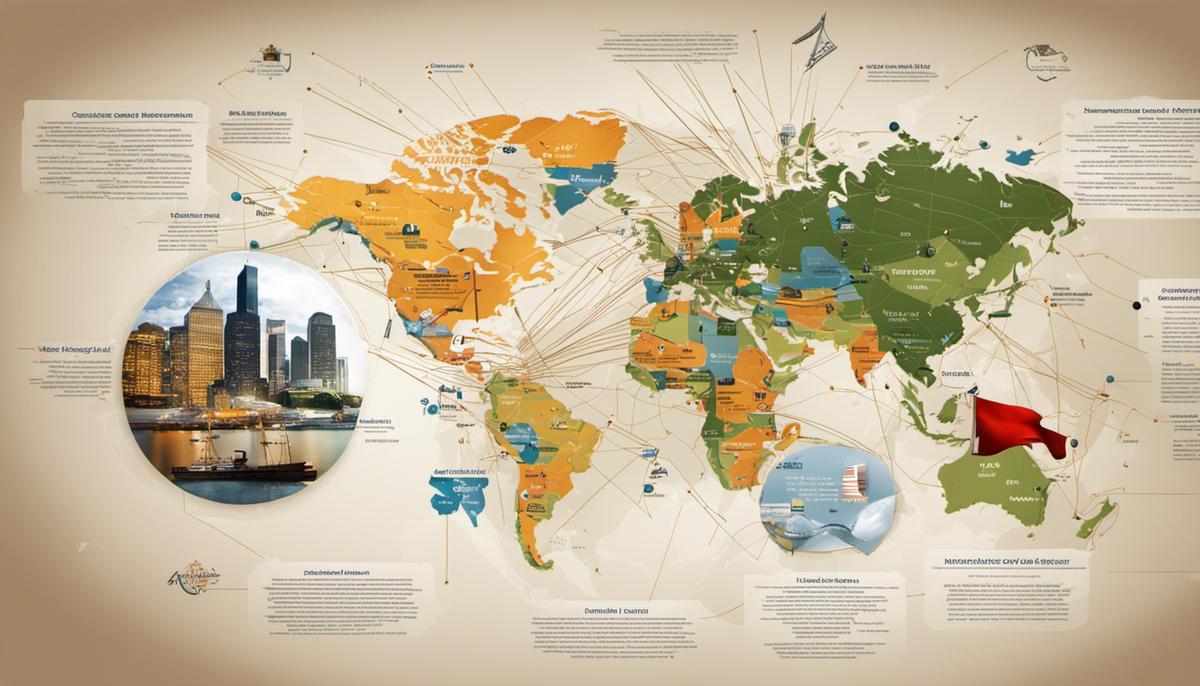In the broad and complex world of insurance, the dynamics vary widely depending on many intricate and interconnected factors. The structure of the industry, the range of services offered, the methods of risk assessment, and wider social, economic, and legal influences all converge to shape each nation’s unique insurance landscape. A comparative exploration of the insurance industry in the United States and Canada, both highly developed yet structurally distinct markets, provides a valuable insight into these dynamics. Within this context, we examine the organization models, product variations, risk evaluation techniques, and the impact of larger socio-population and legal factors on both landscapes.
Table of Contents
The Structure of Insurance Industry in Canada and USA
It’s no secret that insurance is a crucial pillar of the economic landscape, regardless of the nation in question. From rising healthcare costs to damage from natural disasters, insurance mitigates risk and plays a significant role in safeguarding the personal and financial wellbeing of the citizens. Hence, understanding the structure of the insurance industry is undeniably important. Especially when considering North American powerhouses like the USA and Canada, the distinctions in insurance structures are fascinating.
Glance below the surface, and there’s a marked difference in the foundation of these two nations’ insurance industries. Whereas the United States features a largely privatized spectrum, the Canadian landscape is characterized by a blend of private and public sectors. This fundamental contrast echoes in the sectors of life insurance, health insurance, and property-casualty insurance.
In the realm of life insurance, both countries feature robust competition amongst multiple private companies. However, it’s the public sector’s role that sets the Canadian industry apart. The public institution Canada Pension Plan Investment Board dips its toes into the life insurance pool, providing a basic level of income replacement in the event of a policyholder’s death.
Transition into the health insurance sector, and the differences are even more glaring. The US health insurance sphere is a tapestry of private insurance companies, employer-sponsored coverage, and public programs. The Medicare and Medicaid programs cater to the elderly and low-income individuals, while private insurance is predominant for the working-age population.
In sharp contrast, Canada’s health care system, known as “Medicare”, is universally available for all citizens and permanent residents – a publicly funded system where private insurance plays a complementary role, mostly covering services not included in the public health plan like prescription drugs, dental care, and eye care.
In the property-casualty insurance industry, both countries operate on a primarily private, competitive scale. The distinction, however, rings clear in the catastrophe insurance sub-sector. In the USA, the National Flood Insurance Program assumes the role of primary flood insurer, a function that isn’t mirrored in Canada’s industry.
Dig deeper, and there’s another differentiating layer: regulatory oversight. The insurance industry in the USA is state-regulated, leading to 50 different sets of insurance laws and regulations. In contrast, the Canadian market is primarily regulated at a federal level, creating a more uniform set of guidelines across the provinces.
That’s not to say one system is inherently superior to the other. Each is tailored to meet the unique needs and circumstances of its nation, shaped by historical, political, and social landscapes. Whether it’s the blend of private and public in Canada or the plethora of private organizations in the US, each structure has its strengths and limitations.
While entrepreneurs and innovators in the insurance industry need to understand these differences, knowing the intricacies can also equip policyholders to make informed decisions. As the industry progresses and evolves, these distinctions may narrow or grow even more pronounced. One thing is for certain – the insurance game is a constantly changing field. Stay versed, stay informed, and stay adaptable.

Product and Service Variations
A Comparative Study: Navigating Insurance Landscapes in the USA and Canada
In a globe-striding age where business fluidity across borders is paramount, an understanding of differential insurance models is crucial. Both the USA and Canada have unique paradigms that breed innovation, efficiency, and effectiveness across the insurance spectrum.
Deep inside the complexities of the insurance market in both countries, disparities in auto insurance illuminate the chassis of the differences. The nature of private auto insurance in Canada is predominantly territorial, a factor often not considered in the USA. That leads to varying premiums reflecting geographical differences in accident frequency and repair costs, harmonizing prices with risk levels. The USA, however, adopts a more person-centric approach, with pricing determined more prominently by individual driving records, age, and the car’s make and model.
In the realm of workers’ compensation insurance, divergences are even more conspicuous. Nearly all U.S. states mandate employers to hold this insurance. It’s a no-fault system, ensuring employees injured at work receive medical help and wage replacement at ease while safeguarding employers from lawsuits. Canada, on the other hand, operates provincial and territorial systems. It means understanding the distinct regulations and practices is vital for businesses operating across internal borders.
Delving into cyber insurance, an area of rising importance in the digital era, policy types vary quite significantly. The USA provides salient coverage for breaches of data held by third parties, commonly known as third-party cyber liability, a critical component often underrepresented in Canadian policies. Thus, innovative companies working with vast data clusters need to successfully navigate these varying undercurrents.
Despite striking differences, these intricacies present windows of opportunities. Companies can seize distinct advantages offered by each market, such as specialization and risk allocation in the USA, or collaboration for comprehensive risk reduction in Canada, thus fulfilling varying customer requirements.
Moreover, the professional liability insurance market is an interesting domain that witnesses stark differences in litigation rates. The USA’s high litigation risk for professionals leads to hefty insurance premiums compared to Canada, stirring cost considerations for businesses venturing across the border.
Lastly, examining the realm of innovation, Insurtech is blossoming on both sides of the border, yet pathways are profoundly different. The Canadian market appears more agile, thanks to streamlined licensing processes. Conversely, the USA’s intricate regulatory environment necessitates innovative companies to invest more time and resources, but it offers a larger market for targeting diverse needs.
In this dynamic, borderless business environment, comprehension of peculiar differences and similarities is a linchpin to success. Savvy entrepreneurs and innovators must master these variables in their strive for growth, differentiation, and profitability in the enticing markets of America and Canada. Remember, foresight and adaptability in this constantly evolving insurance industry are the keys to outmaneuver your competitors.

Risk Assessment and Pricing
Having addressed these crucial points, let’s delve deeper into our topic by examining the finer details of risk assessment and pricing methodologies between both nations.
A novel facet of insurance in the USA and Canada is the actual way the risk is evaluated and deemed worthy of coverage. In the US, predictive modeling has really taken its place as a frontrunner in risk assessment. Through data analysis, insurers can predict future risks with greater accuracy, facilitating the ability to forecast patterns and potential problems. This technology-centered approach allows for more nuanced risk assessments, price discrimination and segmentation, enhancing the profitability and competitive positioning of insurers.
Contrastingly, Canada’s risk assessment approach leans towards traditional tail estimation methods, bolstered by industry experience which helps to validate and confirm statistical models. Canadian insurers believe in understanding risks in relation to historical precedents and ensuring sufficient capital to address all potential claims. It is not uncommon here to see an inclination towards erring on the side of caution, creating a commendable safety net for policyholders.
Pricing methodologies vary in a similar vein. In the USA, the pricing of insurance tends to be more competitive. Insurers utilize their unique predictive models to compete more vigorously in price differentiation, seeking an edge to stay ahead of the curve. This competitive atmosphere propels innovation, urging companies to create spectacularly streamlined services, policy packages and pricing strategies. The drive for lower prices stimulates a vigorous market, which forces companies to leverage advanced tech and digital solutions, creating a vibrant insurtech landscape in the US.
Canada, on the other hand, has a more collaborative pricing methodology. They favor a balanced approach, with standardized pricing models, which leaves less room for aggressive competition. Regulatory measures adopted by Canadian authorities ensure rates are affordable and equitable, shielding consumers from the possibility of being priced out. This model promotes a more stable market, lending itself to enhanced consumer trust and reliability.
In the midst of these differences, opportunities abound for businesses to leverage the strengths of both markets. Entrepreneurs and innovators can explore efficient risk management systems imported from US methodologies while respecting the high reliability offered by Canada’s more precautionary approach. Understanding these intricacies and nuances is critical for any insurer looking to gain an edge in a highly competitive and globalized market.
As business landscapes continuously change, so do risk dynamics and insurance complexities. Success in this sector, regardless of geography, hinges on the ability to constantly evolve, demonstrate agility, and navigate regulation while keeping consumers and their needs at the heart of every decision. Stay informed, stay ahead, and seize the opportunity.

Impact of Social, Economic and Legal Factors
As we delve deeper into the components of the insurance landscape in Canada and the USA, we’ll uncover the critical aspects that shape these industries and their influence on social, economic, and legal environments.
An intriguing facet of risk assessment methodologies in both countries is the diverse approaches to evaluating and pricing insurance policies. The USA leans towards a more competitive model, with insurance companies free to set prices based on their own calculations and risk assessments. This allows companies to leverage innovation and technology in risk assessment, leading to a more market-driven approach to pricing.
Conversely, in Canada, there is a collaborative insurance market. Insurance companies collectively determine the basic coverage prices, which provides a level of uniformity while still allowing individual companies to compete on additional coverages, customer service, and other value-added services. This collaborative approach indirectly leads to a balanced insurance market, which is less volatile in terms of price fluctuations, thereby providing some form of stability to policyholders.
Auto insurance intricacies add another layer to these differences. In the USA, operators commonly utilize complex algorithms for calculating premiums using multi-faceted risk factors, whereas, in Canada, regulatory bodies limit these factors, thereby making the process more straightforward and transparent.
Now, let’s turn our focus to professional liability insurance premiums. The USA manifests a high litigation culture, which translates to higher professional liability insurance premiums. In stark contrast, Canada’s lower litigation rate results in modest pricing in this aspect.
Moreover, cyber insurance has surged in demand due to the exponential rise in cybercrimes worldwide. Interestingly, the USA and Canada present distinct variations in coverage and policy types. The USA offers highly specialized cyber liability policies with comprehensive coverage, making it an attractive venue for businesses seeking robust protection. However, Canada leans towards a more standard policy offering, which could be a reflection of the different legal and regulatory frameworks present.
The dynamic nature of the current insurance landscape invites diversification and creates possibilities for companies to leverage the advantages of each market. As entrepreneurs and innovators venture into these dimensions, they need to comprehend the unique insurance structures to design products and services that resonate with the respective markets.
When it comes to workers’ compensation insurance systems, the USA paints a picture of individualistic state regulations, allowing for more flexibility and responsiveness to local conditions. On the other hand, the Canadian perspective showcases a provincially regulated system, which ensures uniformity but lacks customization.
In the realm of insurtech, being at the frontier of innovation is valued significantly. Despite their differences, both countries share a common trend: increasing digitization of their insurance sectors. While the USA’s competitive market pushes harder for technological advances and novel products, Canada’s collaborative insurance environment facilitates collective progression towards the same goal.
To navigate this exciting, vast insurance sector, businesses must comprehend the influence of social, economic, and legal factors that reshape these landscapes. As such, understanding the intricacies and nuances of the insurance landscapes in the USA and Canada is paramount, not just for survival, but for a thriving venture in this globally interconnected business environment.

The insurance landscapes of the United States and Canada provide fascinating insight into how diverse influences shape insurance provisions and policies. Key elements such as market structure, product diversity, risk assessment methodologies, as well as socio-economic and legal factors, all interplay to create unique dynamics in each country. By studying these intricate aspects, we trace the path from macro-level influences to micro-level industry operations, shedding light on the realities of insurance affordability and coverage for consumers in these two markets. Gaining comprehensive knowledge about these elements not only fosters better decision-making for consumers but also underpins the evolution of the insurance industry itself.

Soraya Starlight is a seasoned insurance professional with the prestigious Chartered Property Casualty Underwriter (CPCU) designation. With extensive experience in the industry and a sharp analytical mind, Soraya provides readers with in-depth knowledge of insurance products, risk management, and industry trends. Her clear and authoritative writing helps demystify insurance, making it accessible for consumers and professionals alike.

